1lumen selects and reviews products personally. We may earn affiliate commissions through our links, which help support our testing.
Brinyte HL18 Noctua review: Headlamp test
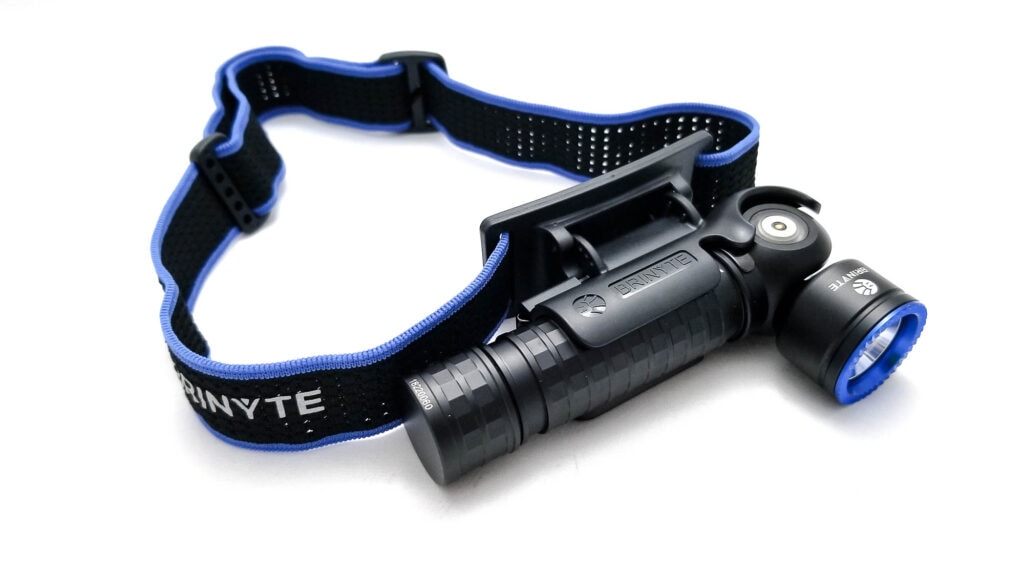
Brinyte HL18 specifications
| Brand & Model | Brinyte HL18 Noctua |
|---|---|
| LED | Luminus SFT-40-W |
| Lumens | 1,600 Lumens |
| Beam intensity | 23,750 cd |
| Battery config. | 1*18650 |
| Onboard charging | Proprietary Magnetic |
| Modes | 5 |
| Blinkies | Strobe, SOS |
| Reflector | Smooth |
| Waterproof | IP66 |
| Review publication date | September 2022 |
Introduction:
Brinyte, formally known as Shenzhen Brinyte Technology Co. Ltd. is one of the other flashlight manufacturers who seem to escape the limelight occupied by bigwig brands like Lumintop, Acebeam, Fenix, Olight, and Astrolux. Even though they have their own R&D, manufacturing, marketing and sales, they don’t make uber-throwers, flooders, or crazy high output photon hawkers like those brands. However, what you do get from Brinyte are no-frills flashlights with quirky features (and cool names!).
1Lumen has reviewed several Brinyte lights over the years, including one of the quirkiest Brinytes in recent years, the HL16. Also known as the Noctua, this was a small 16340 size light with a unique, swiveling head that could be rotated from 0 to 90 degrees to turn it from a tube light into a right angle light. With magnetic charging, a magnetic tailcap, and a headband that turned it into a headlamp, it was a neat light, but came up short performance-wise, and had some quality issues. Fast-forward a while, and now there’s a new HL that slipped in under the radar, the HL18. It’s bigger (18650-size), brighter (a lot), has a new headband mount, throws farther, and has a new LED. It retains the centerpiece swiveling head, so is this round two?
Package quality.
The HL18 comes in a nice, retail-ready package with requisite and appropriately embellished with nice graphics and feature blurbs out back. It’s a generally nicely presentation, and everything is nearly arranged inside. The HL18 was mounted in the headband mount sitting in a molded plastic trap, with the rest of the accessories riding underneath the tray.
- Brinyte HL18 Noctua
- 3100 mAh 18650 battery (mounted in the light)
- Pocket clip (attached)
- Headband
- Headband mount
- Manual (in German)
- 2 o-rings
- Warranty registration card
- USB A to magnetic charging cable
Overall, this is a complete kit and is everything needed to get going. The battery was sitting at about 3.8 volts, a bit high for a storage voltage, but enough to get you going without a recharge. The rigid headband mount was not mounted to the elastic headband, so you’ll have to do that. Strangely, Brinyte included an empty box for the battery in the package. Why? Also, the manual was in German. What’s a guy gotta do to get a manual that doesn’t need translating here?

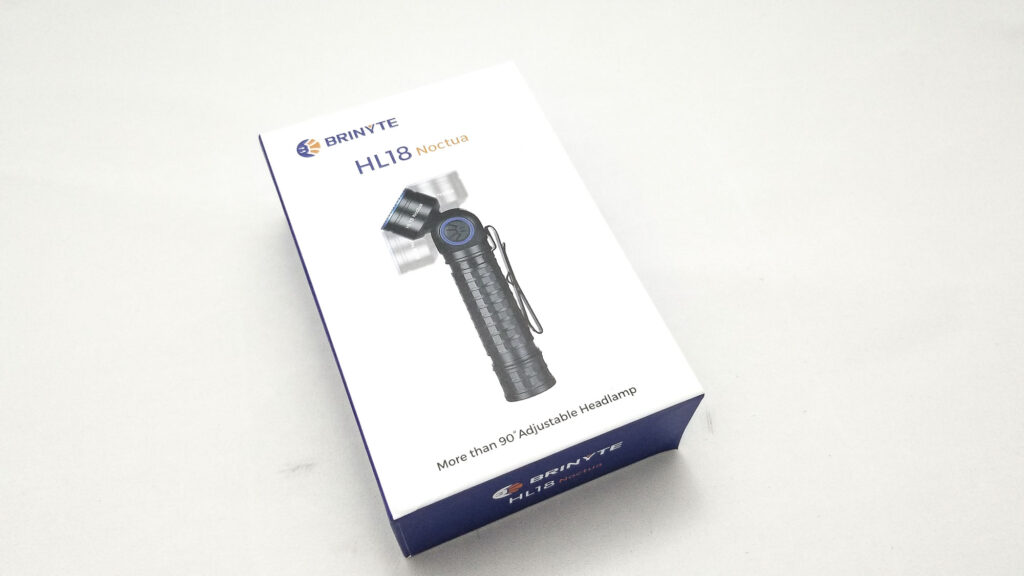
Flashlight in use
The Brinyte HL18 occupies a use-case segment reserved for utility/work lights and headlamps, but it would happily stand in for your Convoy S2+ or or any other 18650 tube light. The swiveling head really does make it very versatile, like the HL16 I reviewed. You can use it like a tube light in the overhand or underhand grip, cigar grip, or swivel the head and use it in the pistol grip like a 90 degree headlamp.
There’s a dual-position pocket clip attached to the light that allows it to be clipped to a hat bill, breast pocket, sleeve, or your backpack strap for hands-free use. Mounted in the headband, it’s a headlamp, and it can be rotated up or down 120 degrees in that mount. The mount has detents at roughly 10 degree increments that held the light firmly in place. The head also has nice detents that hold it in position during jostling or vigorous shaking. There’s knurling on the tube, but it’s more texturing than traditional knurling, and it’s not as grippy as I’d like. There’s a single e-switch on the side of the body below the head, and it’s opposite the magnetic charging pad. The switch is decently large and sits in a blue anodized bezel. The rubber boot is superbly grippy and has the Brinyte logo molded into it, but it isn’t backlit. I didn’t have too much trouble finding it in the dark though. The action is nice: Crisp, snappy clicks and nice feedback. It does take a decent amount of effort to actuate though, which helps with accidental activation.
The tailcap is flat and magnetic, and although I’m not a fan of these on EDC lights, for a working light like the HL18, it’s pretty much mandatory. While not a super-strong magnet like I’m used to, it holds the HL18 perpendicular (albeit it seems barely adequate). Tail standing is just fine, and no chance for it to roll away since the head or pocket clip prevents that. No lanyard mounts on the light itself, but you could affix one to the pocket clip, but alas…if only Brinyte included one.
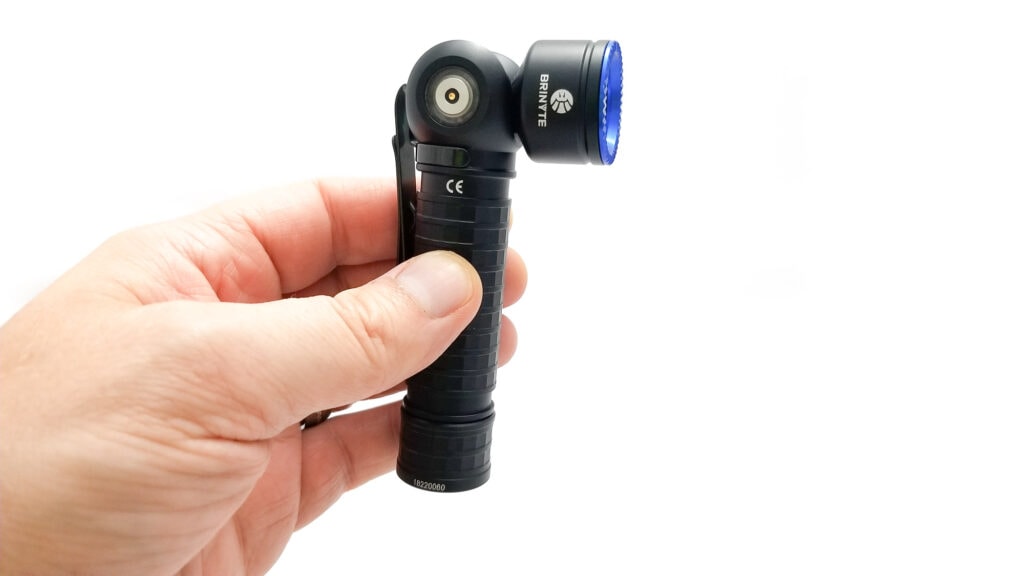
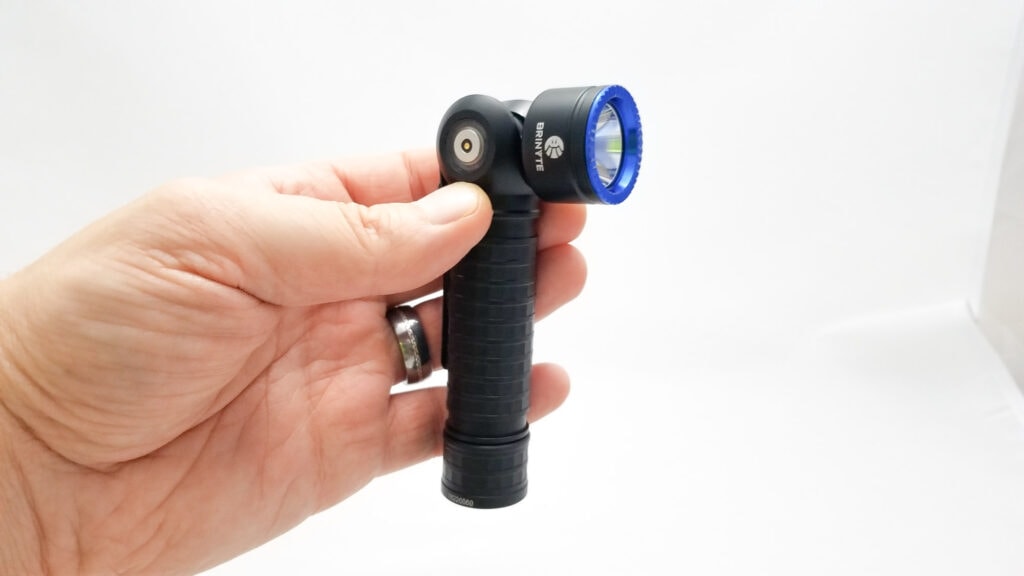
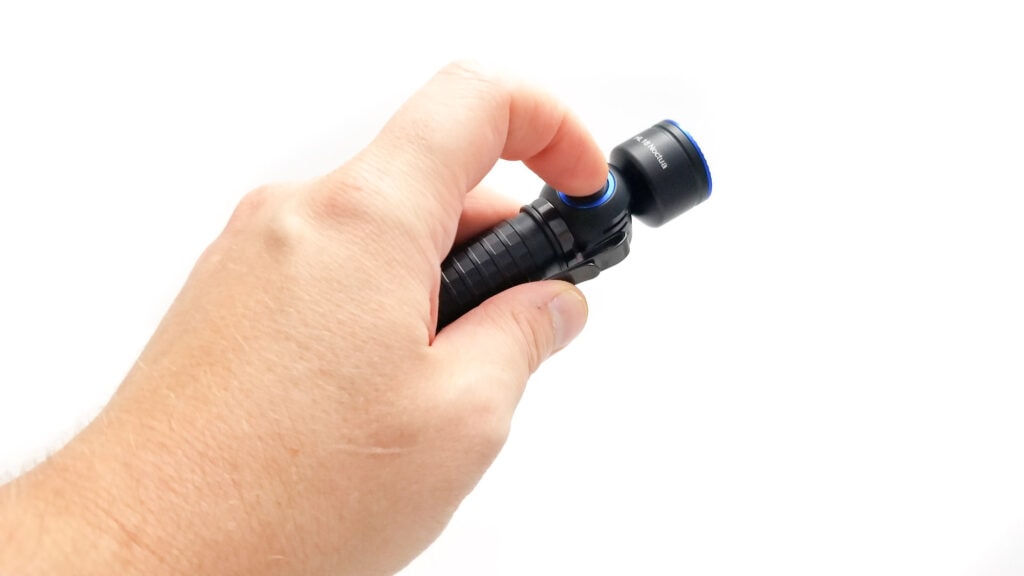
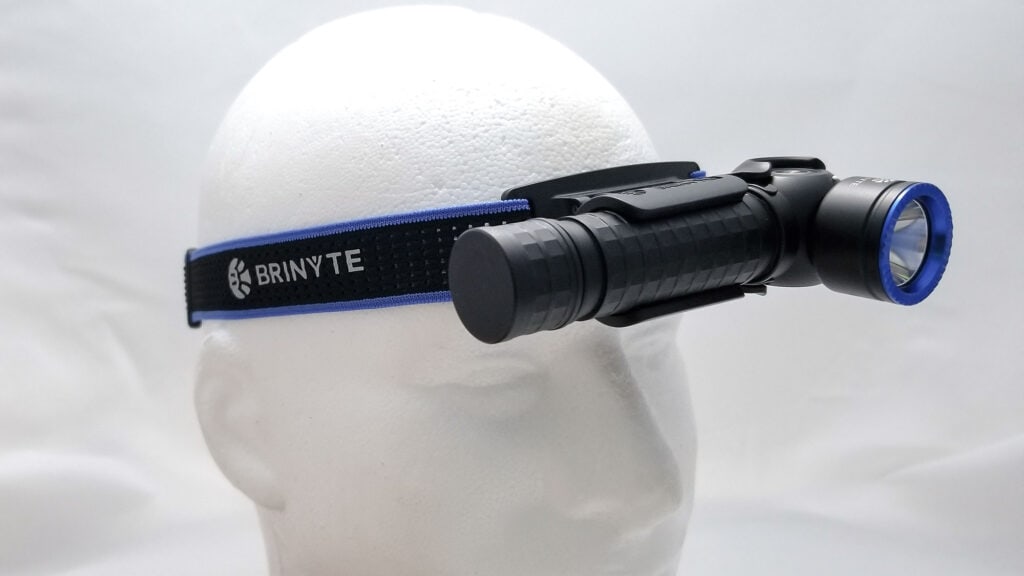
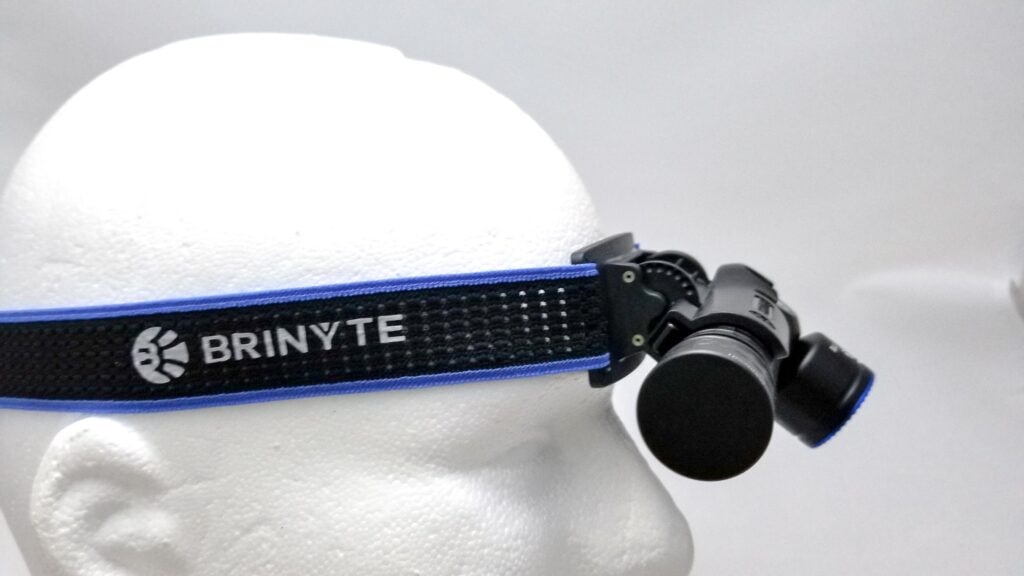
Build Quality, and Warranty
Brinyte lights are generally pretty good quality and nicely built, falling somewhere between Fenix and Olight in quality/price. The HL18 retails for $84.95 direct from Brinyte, and that’s a fair price for this light. It’s unique and doesn’t have much serious competition besides the Nicron lights (which cannot be mounted in a headband). I had a quality snafu with the HL16 I reviewed where the TIR optic was misaligned, but otherwise these are very good quality lights.
The HL18 is no exception, and I didn’t see any quality issues this time. It’s milled from 6061 aluminum, and the machining is flawless. It’s been given the carry melt treatment as well, and all the edges are smooth. The finish is advertised as type III HA, and it looks good. No blemishes, thin areas, or coverage issues, and the text is sharp and has very nice contrast. There aren’t any alarming gaps or misaligned parts either, and the rear threads are rectangular cut, and although a bit fine, are very smooth (and well lubed). The swiveling head is pretty sturdy and had nearly indiscernible play in the mechanism. Very impressive! It has 5 well-defined detented positions from 0 to 90 degrees, and there was plenty of what looks like synthetic grease in the mechanism for smoothness (and water resistance).
There’s a press-fit spring in the tailcap and it’s decently large (and magnetic). There’s also a spring on the driver’s positive end, and that’s great for shock-resistance if dropped since it protects the driver from damage and prevents connection breaks. There’s a single o-ring at the tail, and it’s a bit small, but affords good water resistance. Brinyte gives the HL18 an IP66 rating for ingress protection, which is pretty decent given the complexities and challenges in waterproofing a swiveling head.
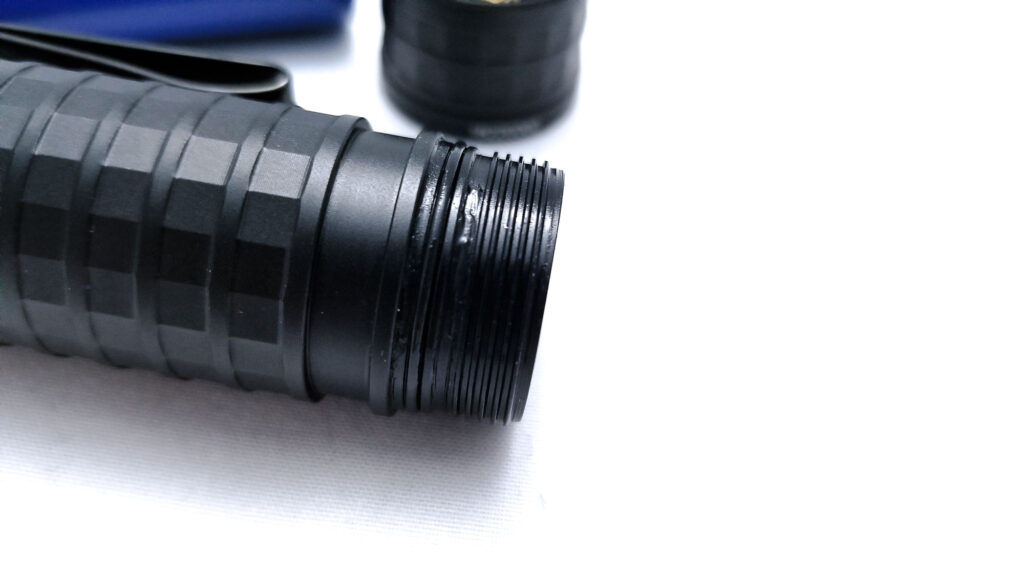
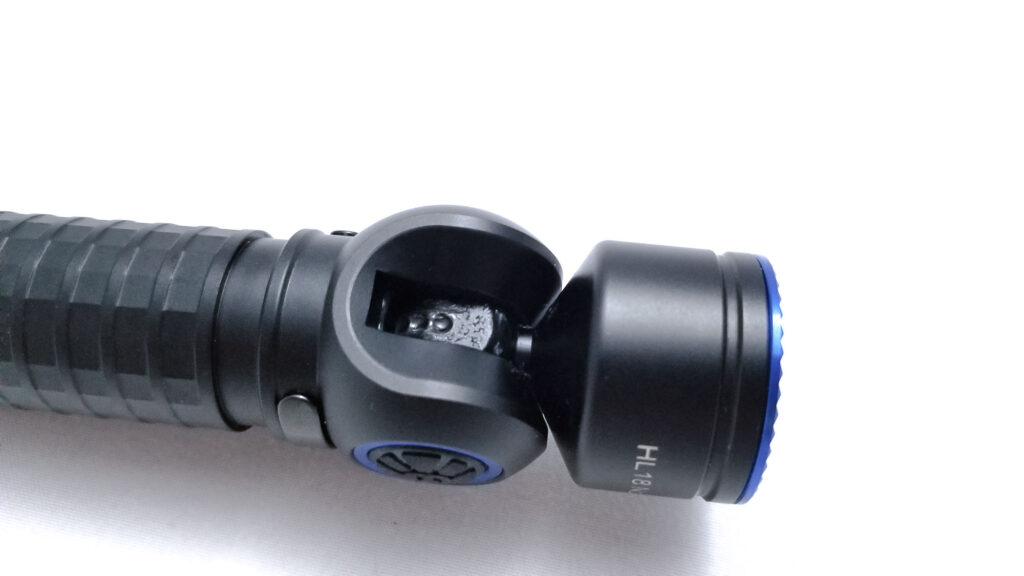
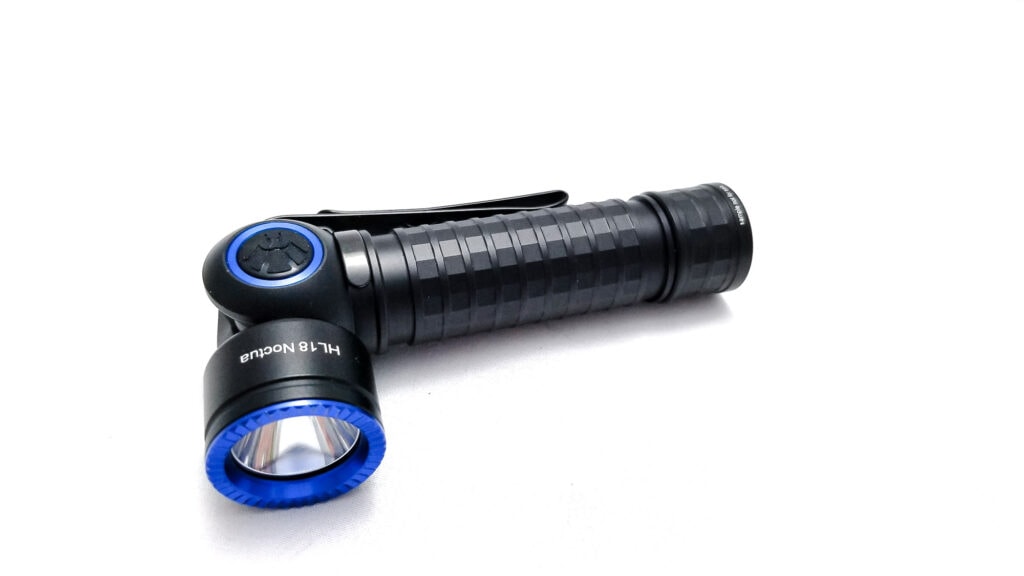
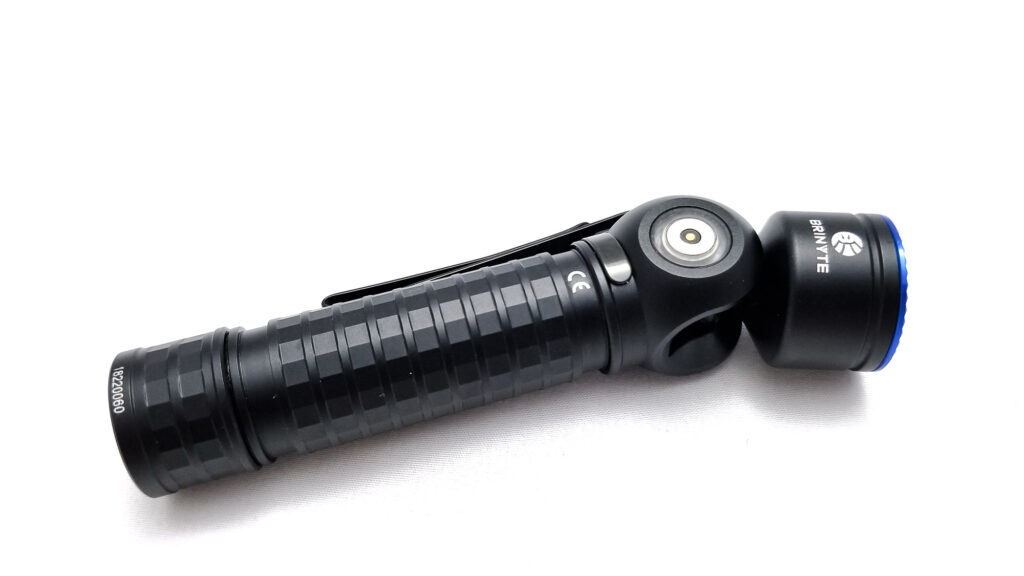
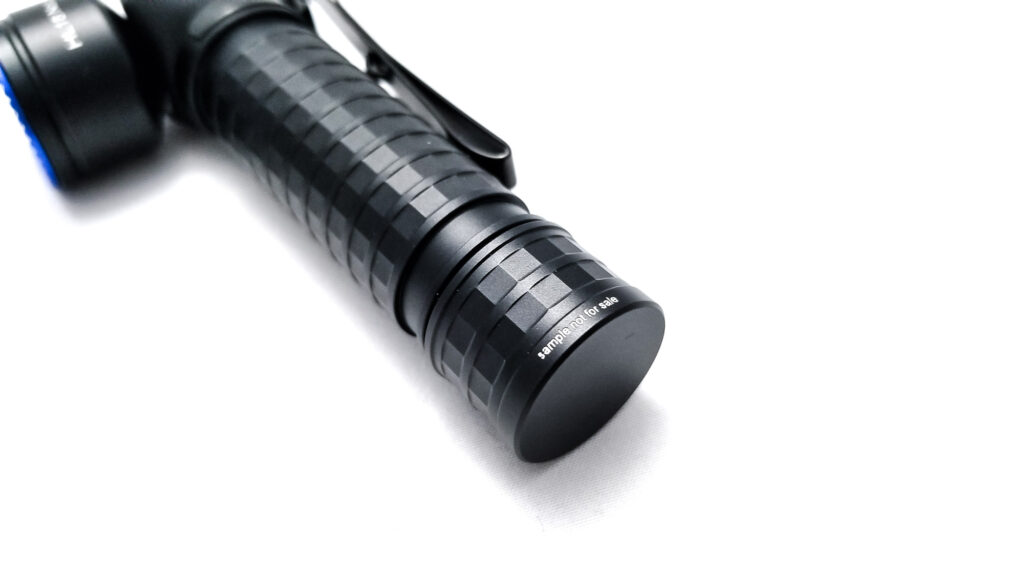
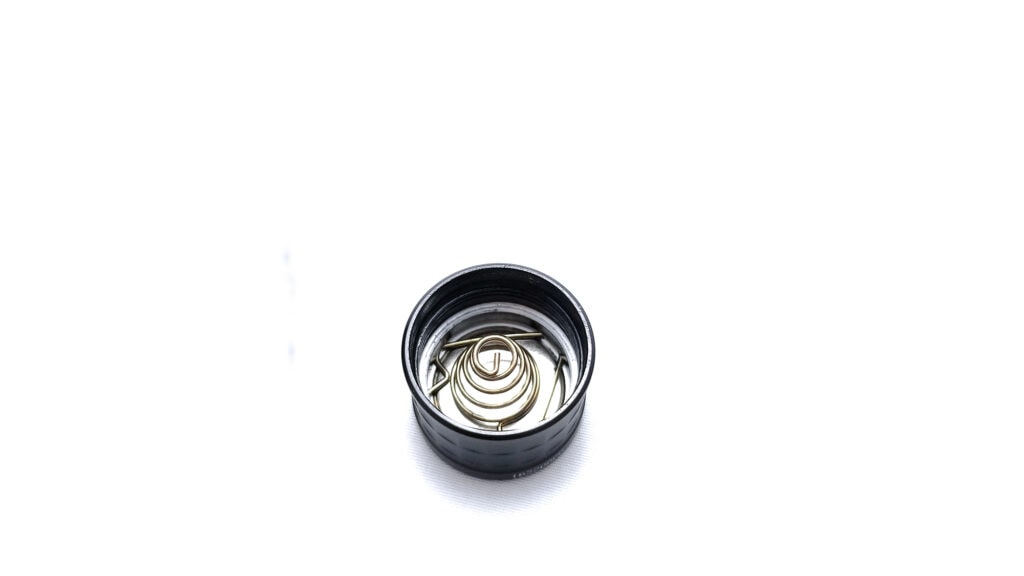
LED, Lens, Bezel, Beam, and Reflector
The major departure from the HL16 is in the LED and optics department. The HL16 featured the Cree XP-G3 LED, which was a 3535 size LED known for its high output and low thermal resistance for good efficiency, but terrible beam characteristics in the obligatory CW tints. The HL18 boots the Cree product for a Luminus product, their flagship high-intensity 5050-size LED. I am of course referring to the SFT-40-W. This LED has taken the industry literally by storm, with every manufacturer now fielding it, so sticking it in the HL18 was smart.
Again, folks this is not a de domed SST40. It’s an entirely different layout and design with 4 bond wires imbedded in the substrate with a domeless LES a bit bigger than an Osram W2. It gets very bright and can really hurl the photons thanks to a very high cd/mm2 even from small, shallow reflectors. The HL16’s TIR has also been binned in favor of a traditional SMO reflector. It’s set under a mineral glass lens protected by a cool micro-crenulated blue anodized bezel. I didn’t notice any AR coating on the lens, but the lens is very clear, and the reflector is flawless with the SFT-40-W centered with a white centering ring. The beam is nicely tuned for this application, with a large hotspot, minimal corona, and a nice transition to the bright spill. There’s a slightly dim inner ring, but it’s not intrusive at all, and there’s tons of side illumination with this with a nice distance. The Opple Lightmaster Pro shows the tint at 5960K and CRI 64.3 Ra. The Duv is 0.0087 on Turbo 1 meter from the sensor.
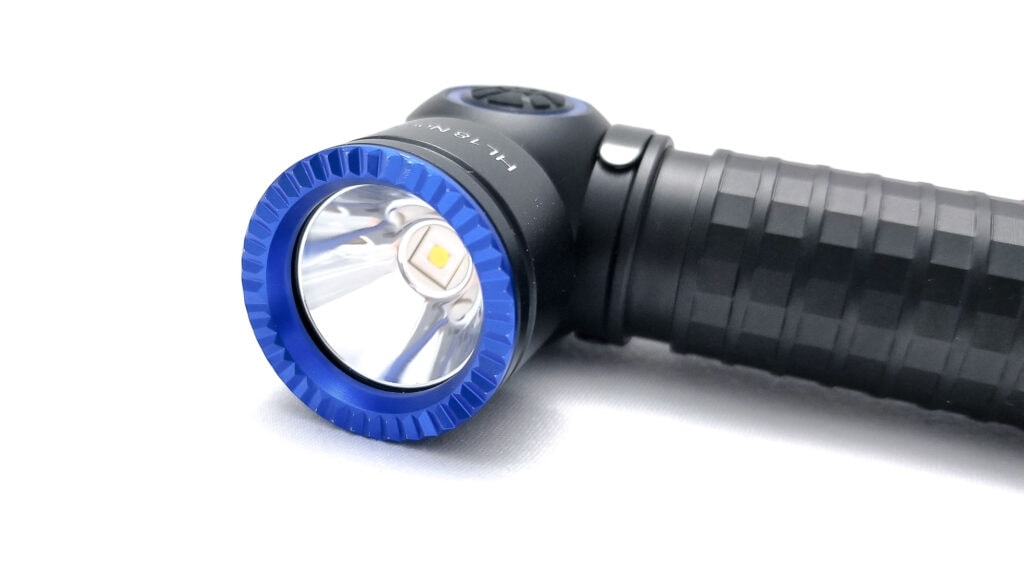
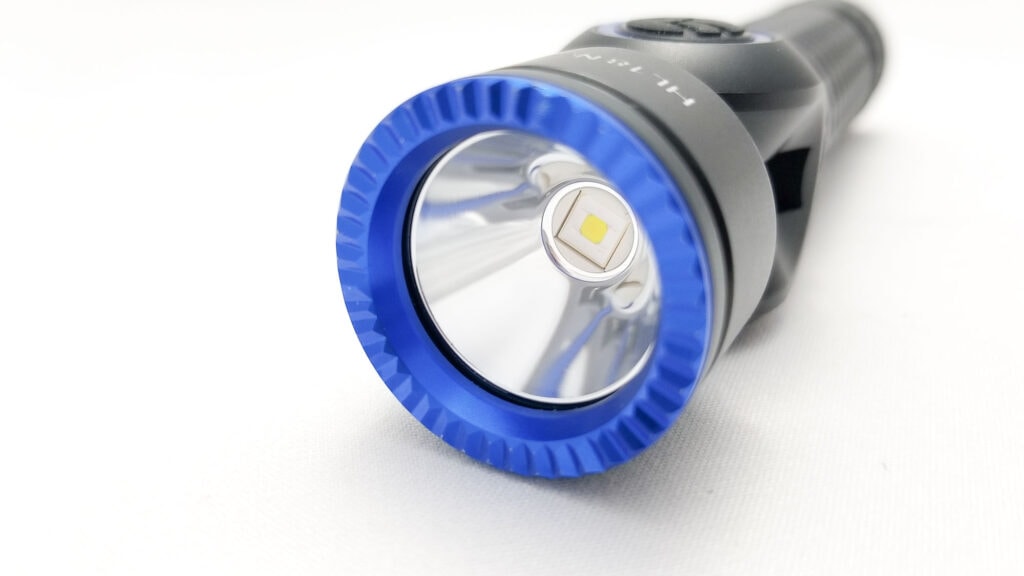
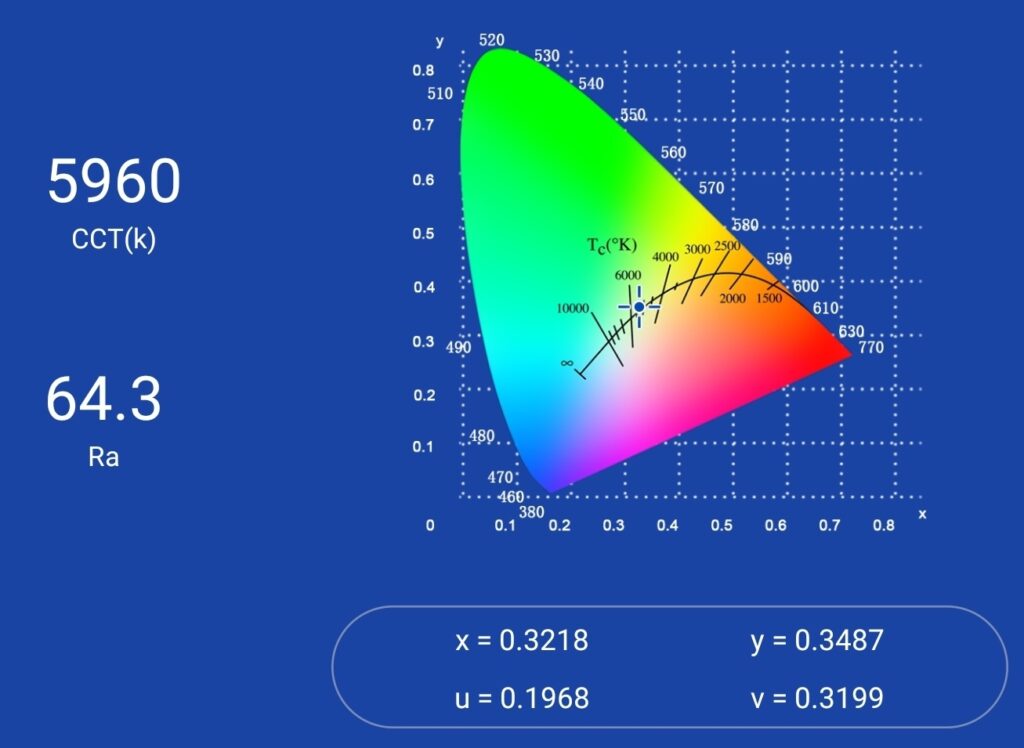
Dimensions and size comparison
Dimensions:
| Dimension | Millimeters | Inches |
|---|---|---|
| Length | 127.5 | 5.02 |
| Head diameter | 27.5 | 1.08 |
| Body diameter | 26 | 1.02 |
Weight:
| Weight | Grams | Oz. |
|---|---|---|
| Without battery: | 89 | 3.2 |
| With battery | 138 | 4.9 |
| With battery+headband | 173 | 6.1 |
Flashlight size comparison with its competition
I compared the HL18 to some other great headlamps and right-angle lights, including the HL16.
Group 1 left to right: Brinyte HL16, Brinyte HL18
Group 2 left to right: Brinyte HL18, Brinyte HL16, Fireflies PL47G2 (21700 tube), PL47G2 MU (22430 tube)
Group 3: Back row: Slonik D10 headlamp. Front row: Brinyte HL18, Cyansky HS6R
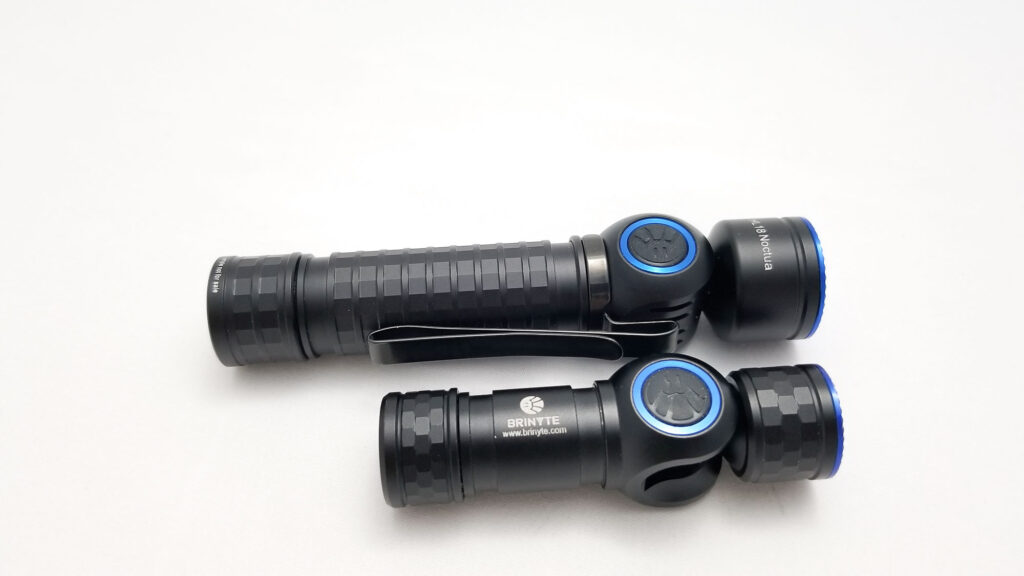
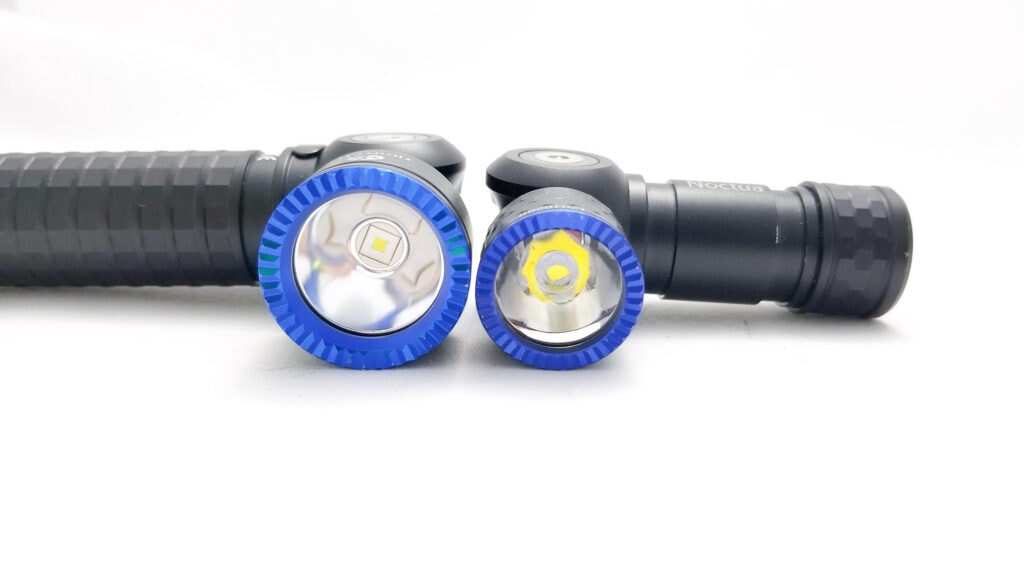
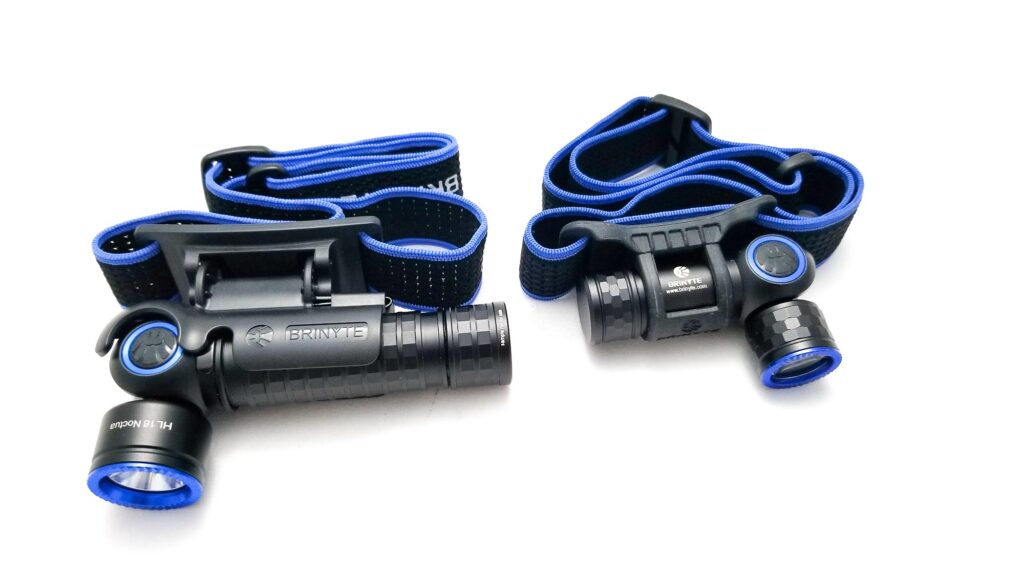
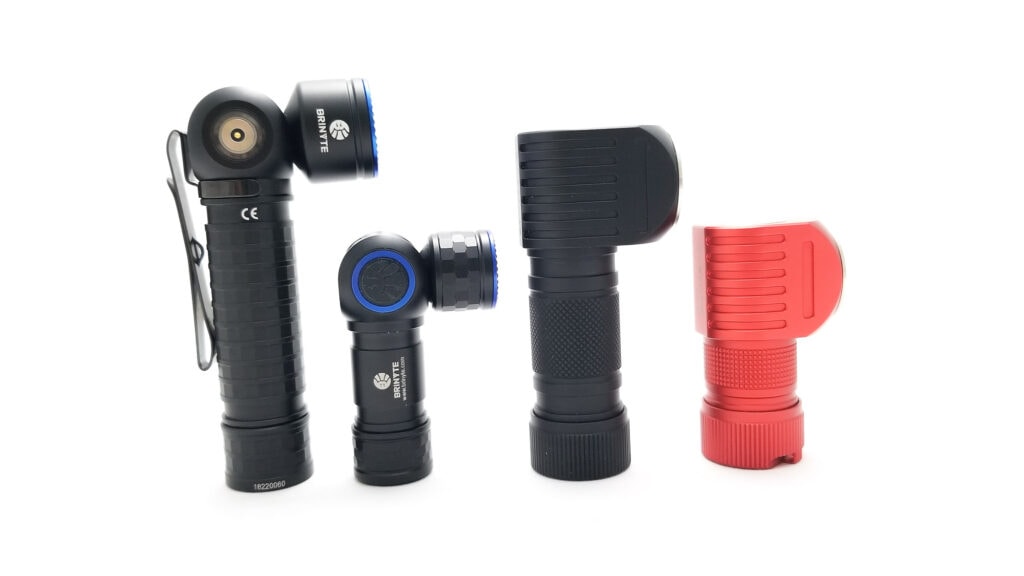
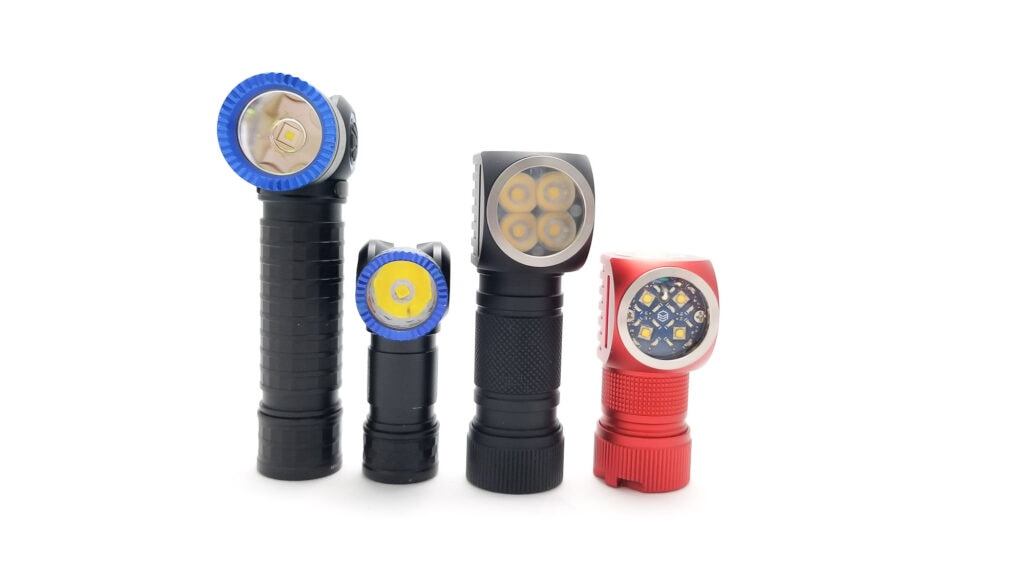
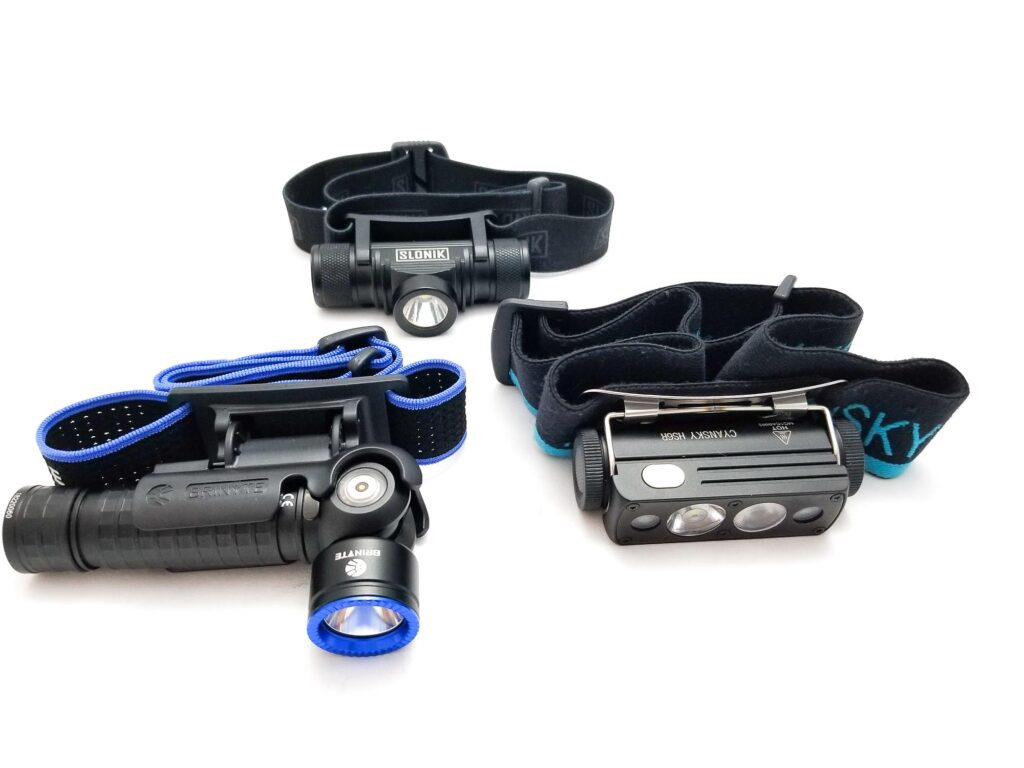
Driver & User Interface:
No word on the driver from Brinyte, but I suspect it could be a buck driver. The runtime test will disclose that of course. Brinyte typically packages their lights with buck drivers, and it justifies the higher price of admission.
The UI is similar to the HL16, and that’s okay, but I wished they had made some improvements to it for the HL18 since it was a bit quirky.
Available modes: Moon, Low, Medium, High, Turbo
Available blinky modes: Strobe, SOS
User interface:
From OFF:
- Press and Hold: Moonlight.
- Single click: Turns on in last used mode
- Double click: Turbo
- 3 clicks:Strobe. Click 3 more times for SOS
From ON:
- Press and Hold: Switches modes Moon-L-M-H-T-Moon
- Single click: Turns off
- Double click: Turbo
- 3 clicks: Strobe. Click 3 more times for SOS
Mode memory:
- Yes, last mode memory. Turbo and the blinky modes are not memorized
Shortcuts:
- To Moon: Press and hold from off
- To Turbo: Double click from off or on
- To Strobe: Triple click from on or off
- SOS: Triple click in Strobe mode
Low voltage warning:
- The LED indicator under the charging pad shows battery state: Solid green 100% to 30% solid red 30% to 10%, flashing red 10% to 0%.
Strobe/blinkies
- Strobe, SOS
Lock-out mode:
- Click 5 times from off to activate the lockout. The light (annoyingly) blinks twice in Mid mode to indicate the lock. The LED indicator turns green when the switch is pressed while locked. Repeat to unlock (again, annoyingly) the light blinks twice on Mid to acknowledge the unlock.
PWM
- Not visible
Additional info on the UI:
- This is a nice UI. It’s simple, easy to learn, has nice mode spacing, and I think it’s suited well to a headlamp with the one click on, one click off. It did take some practice to get used to Moon and Turbo being both part of the regular mode group, with Turbo also being accessible with a double-click. I don’t run across that functionality very often and it’s welcome here. It would make for a very versatile EDC light as well. There’s no evidence of thermal throttling during the tests, and no visual LVP notifications.
Batteries & Charging
The HL18 uses an 18650 size lithium ion battery for power, and this is a great battery for a headlamp since it’s smaller than a 21700 or 20700, but has much more energy and capacity than an 18350, and strikes a good balance between capacity and weight. The light includes a Brinyte-branded 3100 mAh 18650 battery. It’s a button top cell with a built-in protection board for over discharge and overcharge protection. I stuck the battery in my VapCell S4+, and it shows about 16 milliohms for internal resistance.
It’s not a proprietary battery, and thanks to the dual springs, flat top unprotected cells will work fine. I tried a Sony VTC6 with no fitment issues. The HL series, along with other Brinyte lights like the Oathkeeper and Artemis feature Brinyte’s proprietary magnetic charging solution. Like Olight’s MCC system, it consists of a standard USB type A plug on one end and a magnetic connector on the other with a pogo pin in the middle and outer contact ring. The connector interfaces with the pad on the side of the HL18 body and the translucent ring around the pad turns red to indicate charging and turns green when the charge is finished.
While I like this setup since it eliminates a charge port that can let water and crud inside the light, unless you remove the battery to charge it, you’re stuck with this setup. Lose the cable and you need a new one. The charge cable from the HL16 worked fine, but I’m not sure if the ones for the Artemis and Oathkeeper would work though. The charging speed maxed out at 1.05 amps. It starts slow and gradually ramps up over about 10 minutes. You have access to Moon, Low and Mid modes during charging, which is very handy since you’ll never be without light.
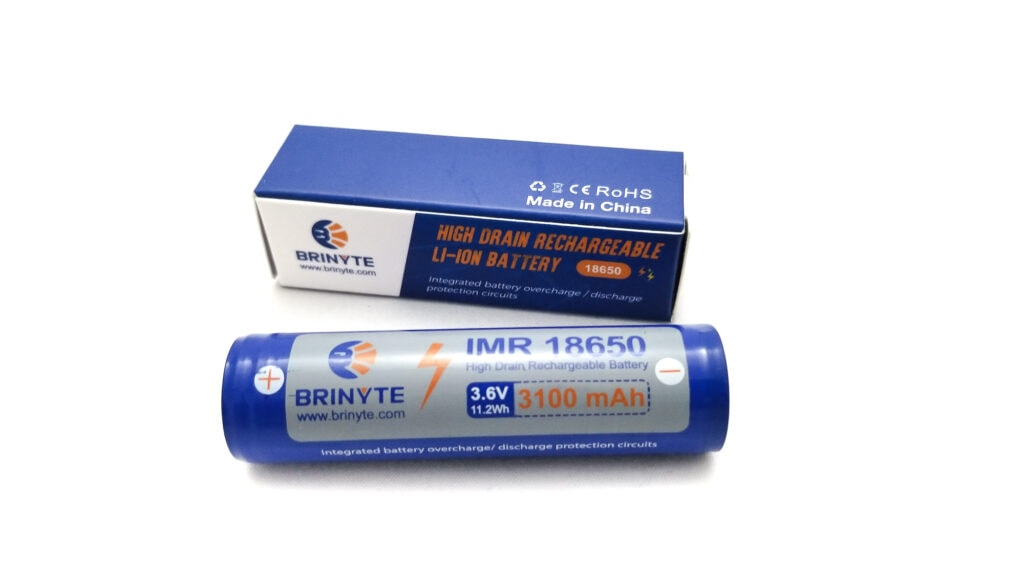
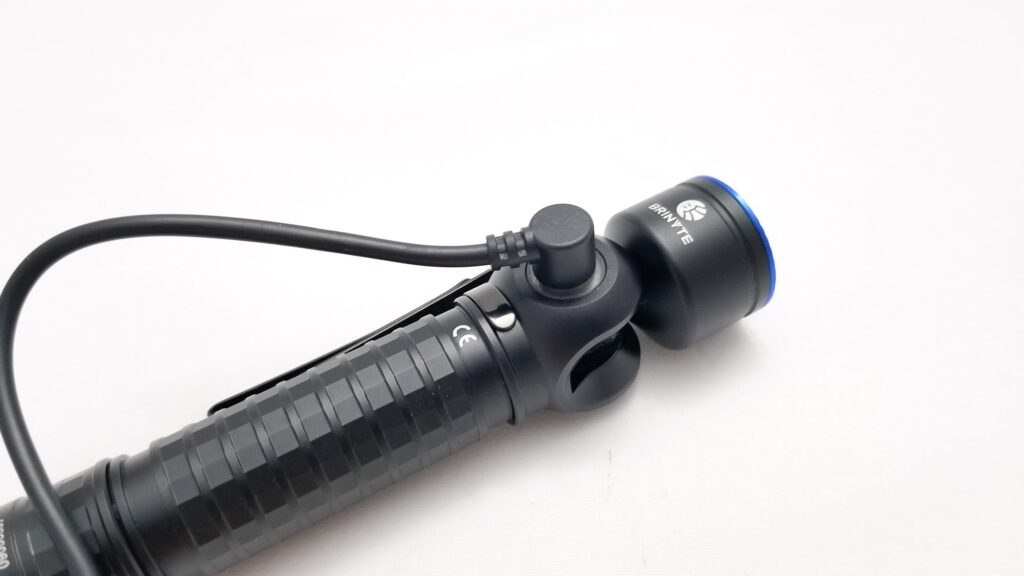
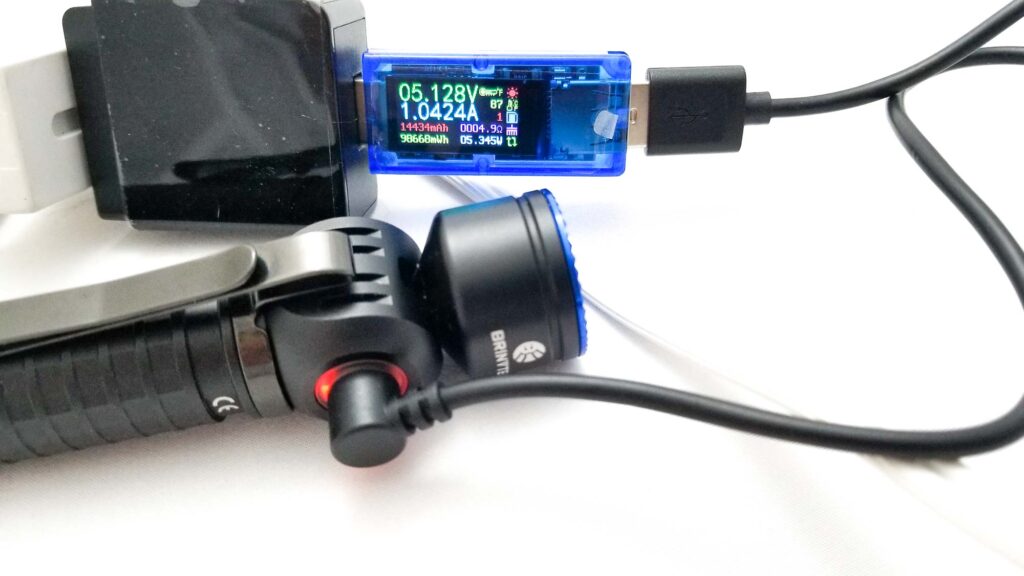
Performance test
Lumen measurements
Lumens are measured using my home made 50 cm integrating sphere, and I use a Digi-Sense 20250-00 datalogging luxmeter. The sphere has been calibrated using many lights of known output and is accurate within 10% of actual output. All measurements taken at 30 seconds using the fully charged included 3100 mAh battery. Amps were measured with my Thsinde 18B+ multimeter with 14 gauge wires in the meter and higher currents with my FY219 clamp meter and a loop of 12 gauge wire.
| Mode | Amps at start | Specs | turn on | 30 sec | 10 minutes |
|---|---|---|---|---|---|
| Moon | 28 mA | 10 | 10.64 lm | 10.64 lm | – |
| Low | 135 mA | 50 | 64 lm | 64 lm | – |
| Medium | 370 mA | 150 | 175 lm | 172 lm | 171 lm |
| High | 1.71 A | 620 | 712 lm | 687 lm | 400 lm |
| Turbo | 6.55 A | 1600 | 1725 lm | 1537 lm | 450 lm |
Parasitic drain:
- 1.27mA
Battery Life: Runtime graphs
Runtimes are measured using my home made 50 cm integrating sphere, and I use a Digi-Sense 20250-00 datalogging luxmeter. I used the included, fully charged, Brinyte 3100 mAh 18650 for the test and measured Medium, High, and Turbo modes.
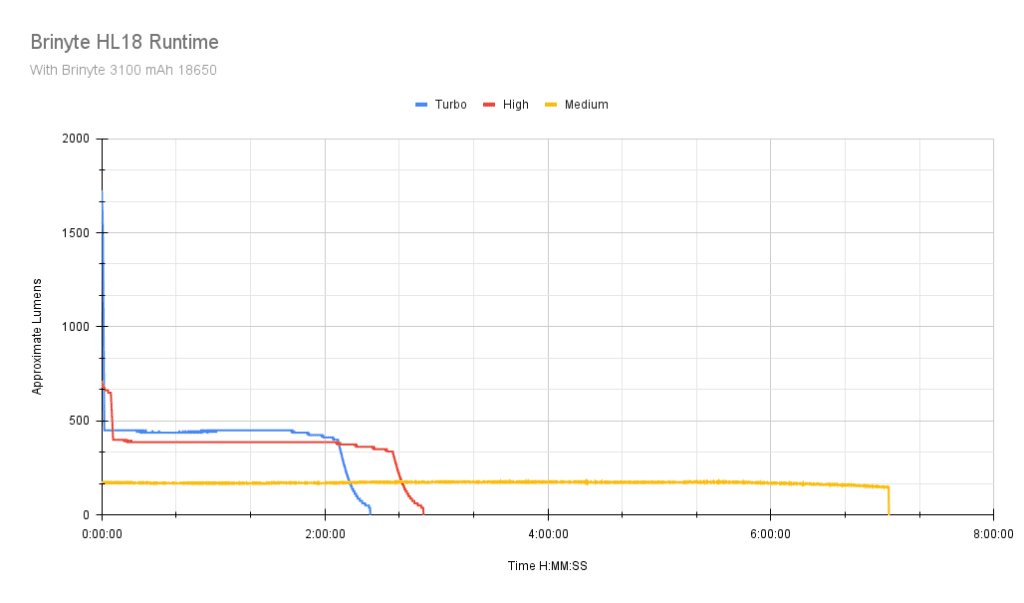
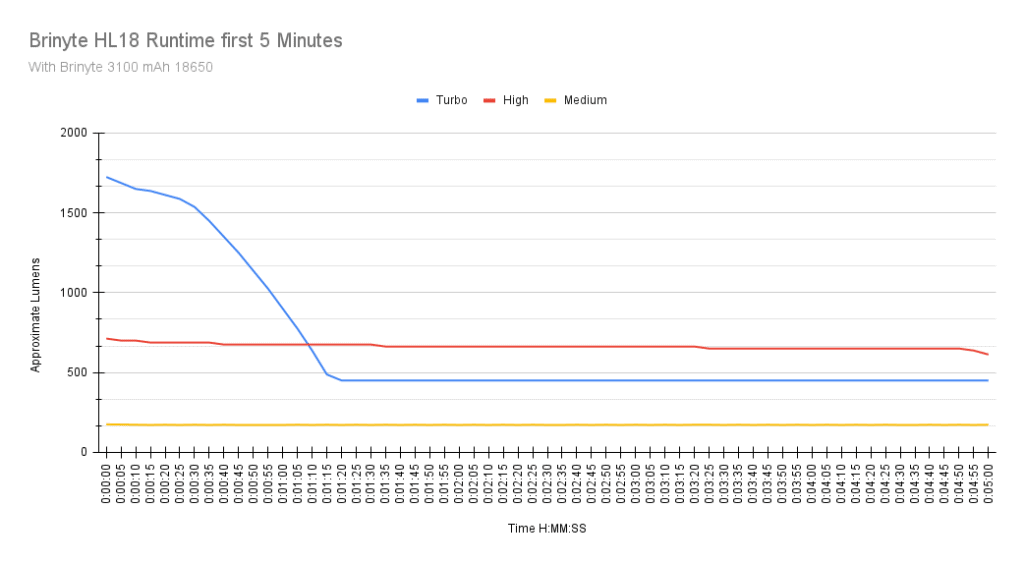
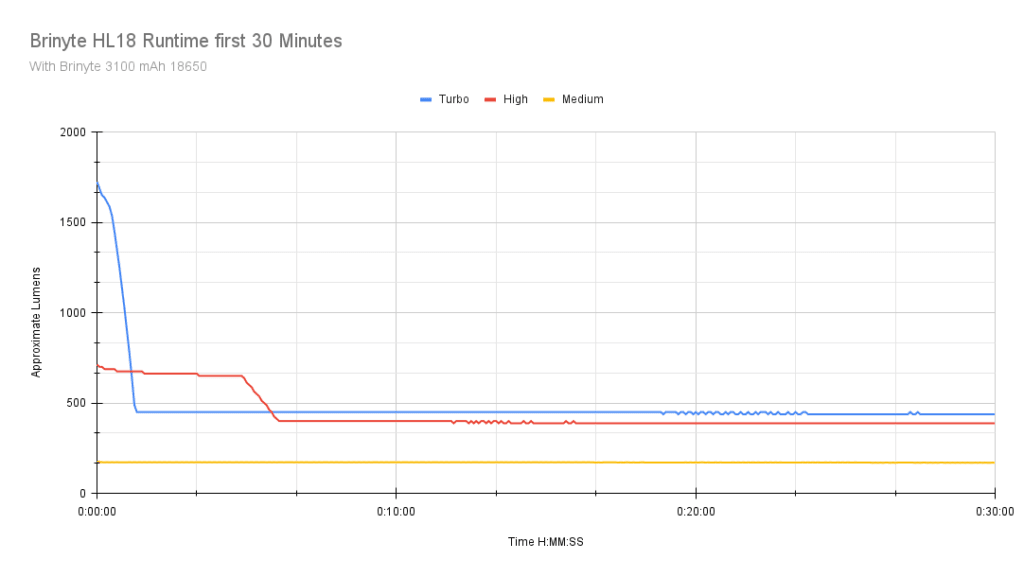
| Mode | Specified | Measured runtime (ANSI) | Time till shut off |
|---|---|---|---|
| Moon | 120h | – | – |
| Low | 25h | – | – |
| Med | 8h 30min | 7h 03min | 7h 03min |
| High | 3h 05min | 2h 48min | 2h 53min |
| Turbo* | 2h 06min | 2h 13min | 2h 24min |
With a small head, disconnected heat path, and minimal heat sinking, the light heats up very fast on Turbo: from 26 C ambient to 44 C in 5 seconds, 53.7 C by 10 seconds, and 57.6 C by 15 seconds. The heat from the LED is mostly concentrated at the head of the light, and it takes quite a while for it to migrate to the rest of the light. I measured a max temp of 60.3 C at 30 minutes in. The benefit of a light like this is you can hang onto it for a while on Turbo. It never really got uncomfortably hot, but definitely warm at 50.6 C at 1 hour into the Turbo test. The light was usable after the tests, but Turbo was not available and I only got Low and Medium modes. The battery was discharged to around 3 volts each time.
ANSI FL1 standards: The runtime is measured until the light drops to 10% of its initial output (30 seconds after turning on). This does not mean that the flashlight is not usable anymore. The last column shows how long the light actually works till it shuts off. If there is a + symbol, it means that the test was stopped at that particular point, but the light was actually still running. This happens on certain occasions, with certain drivers, firmware, or batteries.
Peak beam intensity and beam distance measurements
Throw was measured indoors at 5 meters using the Uni-T UT383S luxmeter. Measurements taken at 30 seconds. I used the fully charged 3100 mAh battery for the testing.
| Mode | Specs | Candela measured | Meters | Yards |
|---|---|---|---|---|
| Moon | ? | 150 cd | 24.49 | 26.78 |
| Low | ? | 1000 cd | 63.24 | 69.16 |
| Medium | ? | 3125 cd | 111.8 | 122.26 |
| High | ? | 13,200 cd | 229.78 | 251.29 |
| Turbo | ? | 32,050 cd | 358 | 391.5 |
Brinyte only lists a single candela figure for the HL18 23,750 cd (probably Turbo). I got a bit more than that, but the UT383S reads high sometimes. Still, the HL18 turned in some impressive throw specs for a small reflector.
Extra info: Peak beam distance according to ANSI FL1 standards: The calculated value of distance in meters at which the flashlight produces a light intensity of 0.25 lux. (0.25 lux is about the brightness of a full moon shining on an object).
Beamshots
The fence is 95 meters away. Photos were taken with my Samsung Note 8 set to 0.3s ISO 200 and 5000K WB.
Beamshot comparison:
- Brinyte HL18
- Brinyte HL16
- Cyansky HS6R (flood, spot, and flood+spot modes)
- Slonik D10 with Luminus SST40 5000K
- Fireflies PL47G2 2021 (4000K SST20)
- Fireflies PL47G2 MU mule light
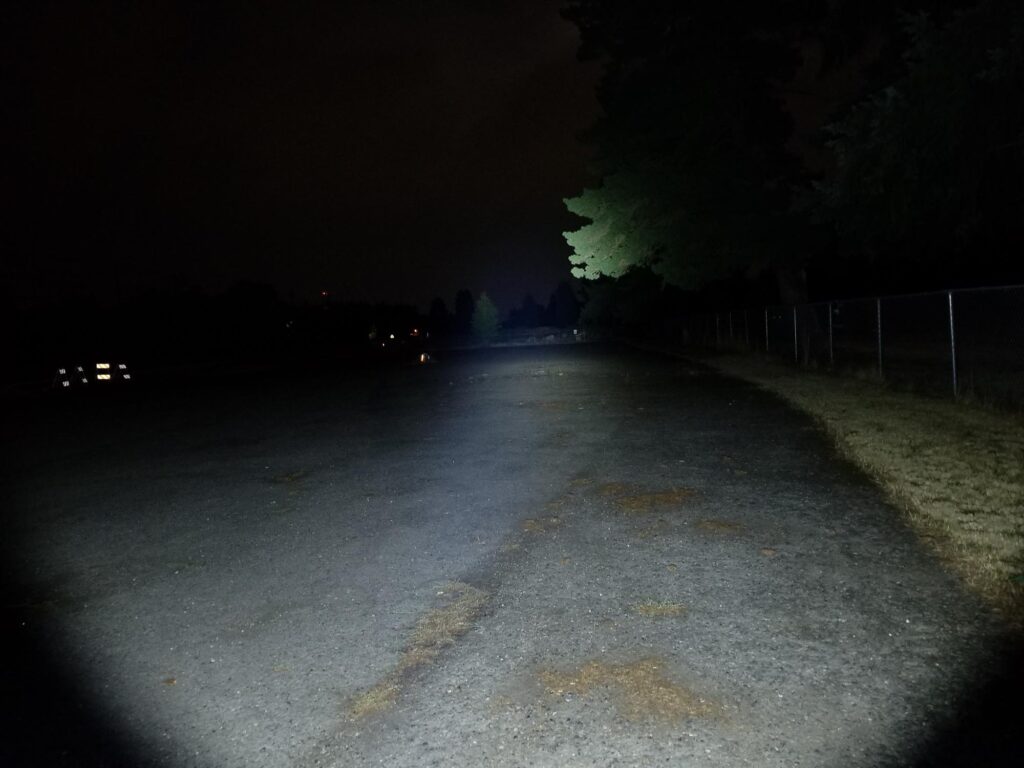
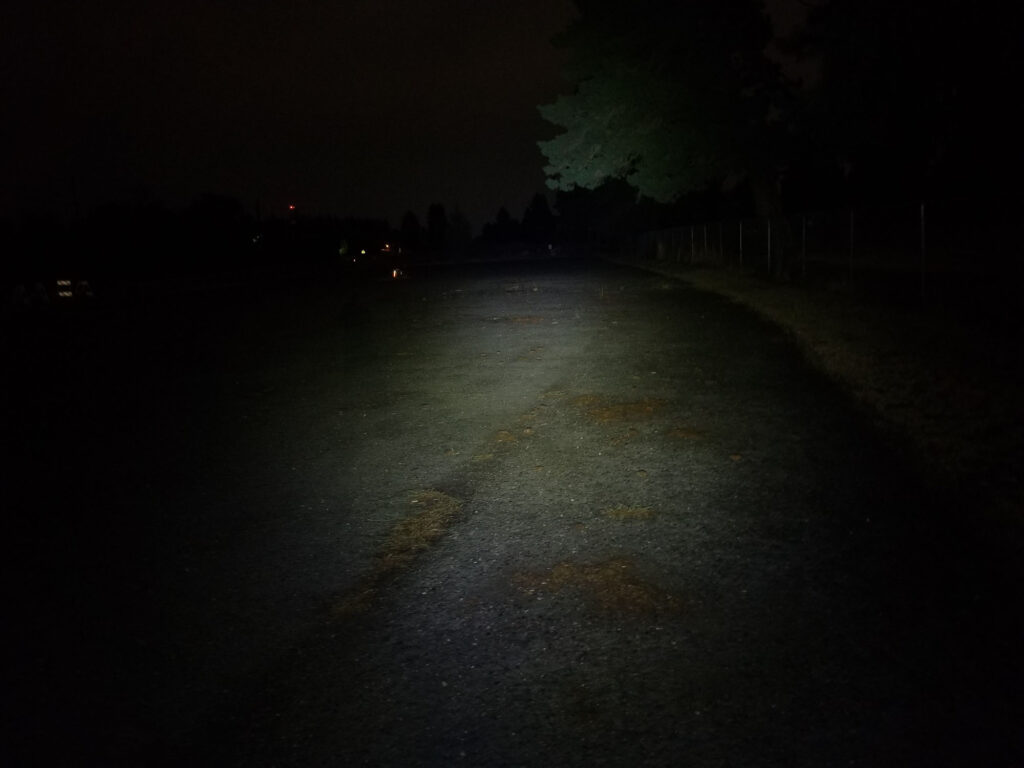
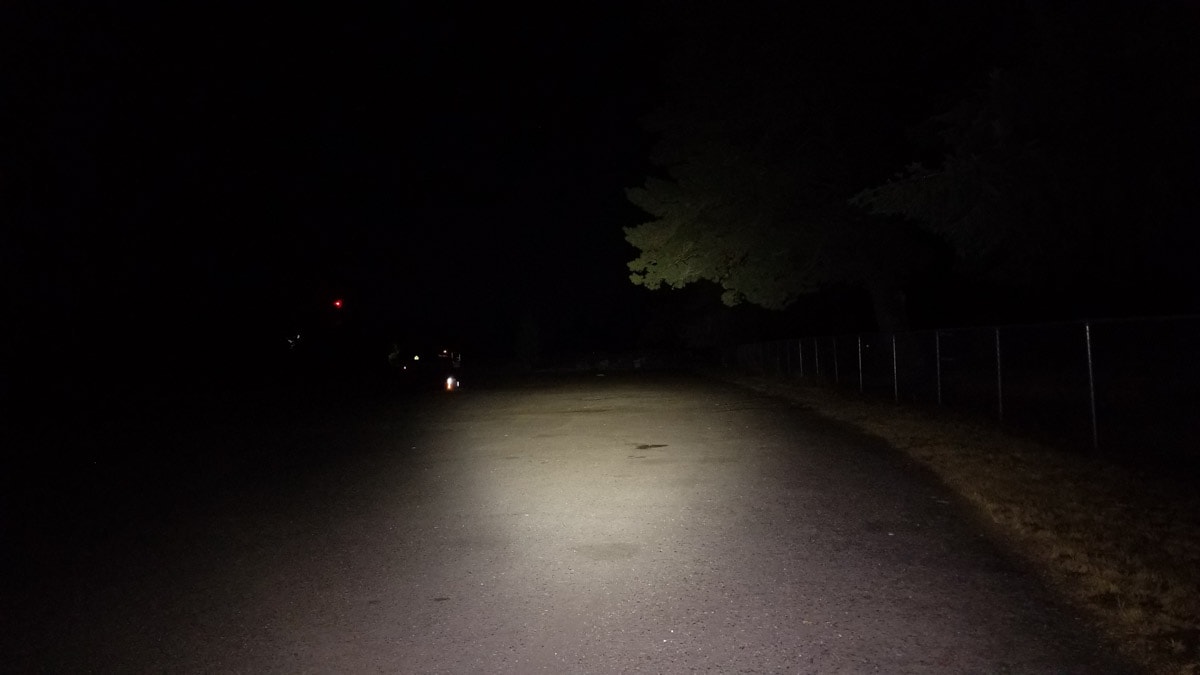
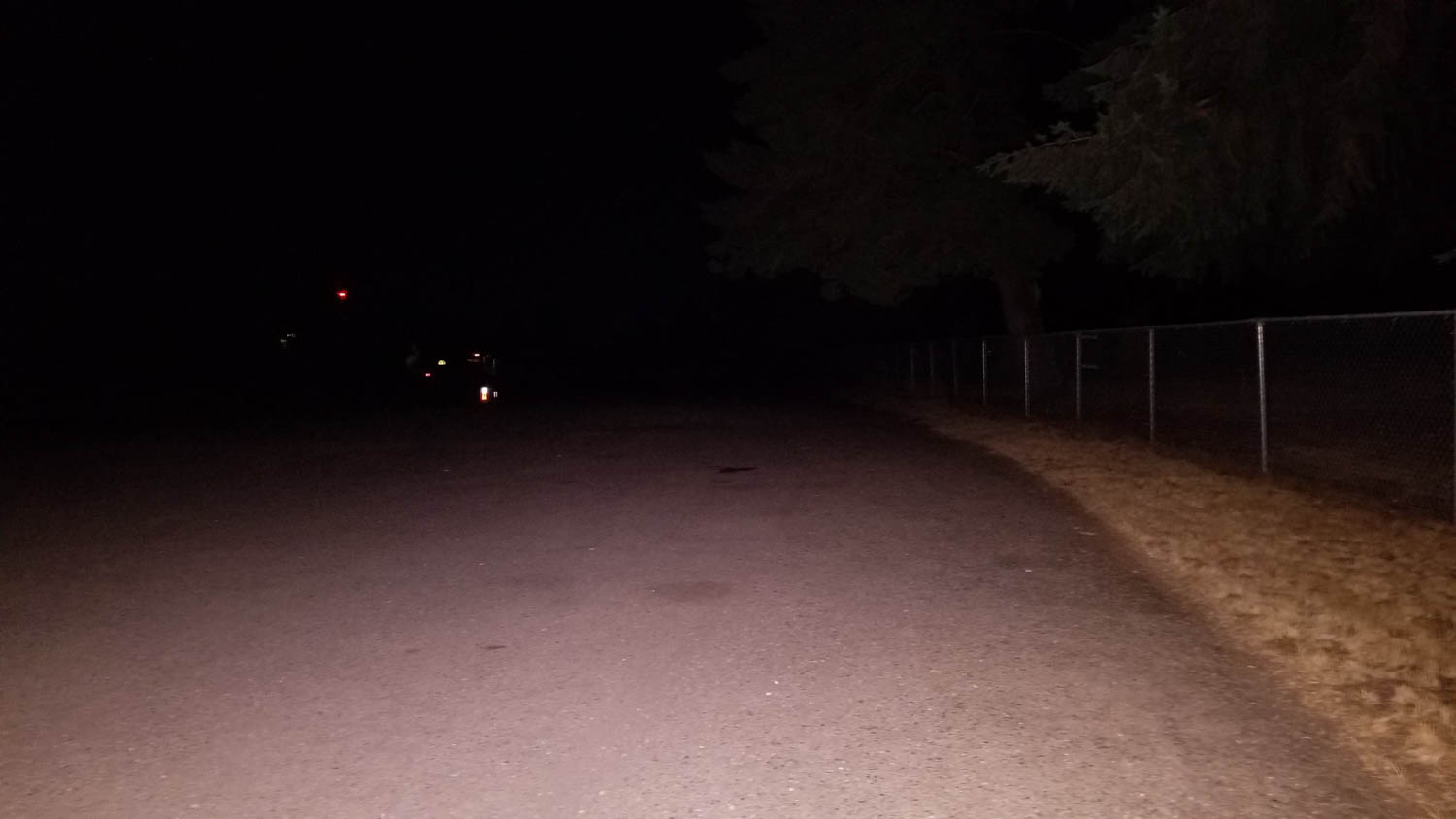
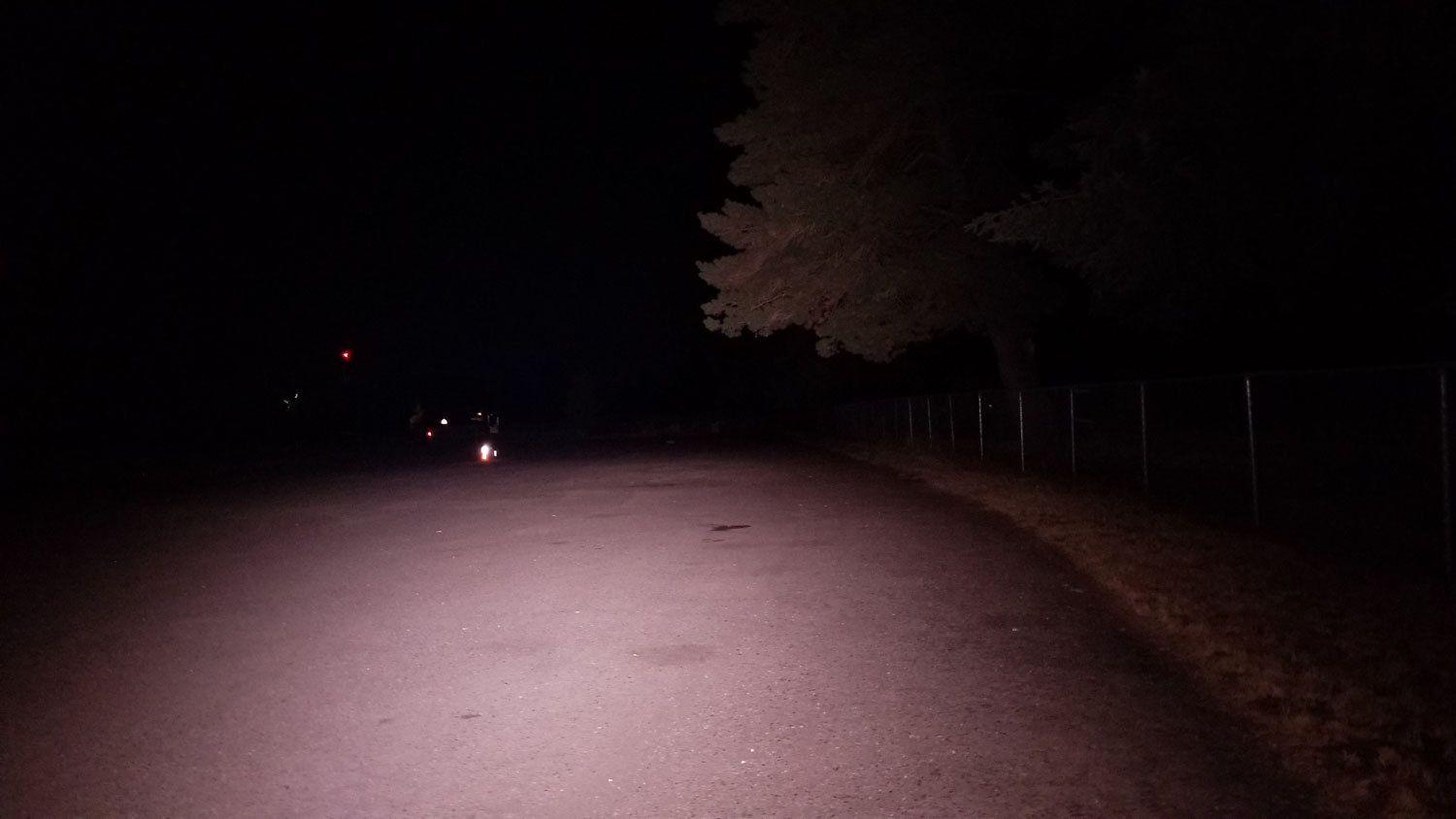
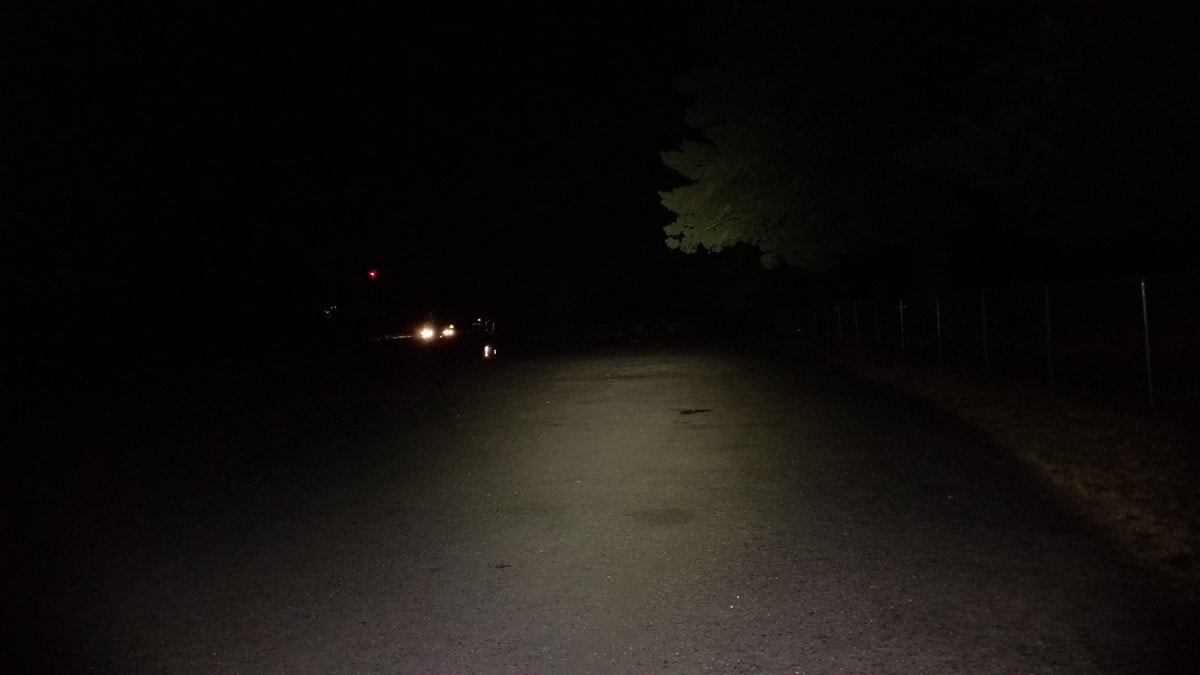
Disclaimer: This flashlight was sent to me for review at no cost by Brinyte. I have not been paid to review, nor have I been holding back on problems or defects.
Final Verdict
Pros
- Innovative headband mount
- Useful swiveling head design
- Great build quality
- Very bright with great throw
- Nice, clean beam
- Easy to use, thoughtful UI
Cons
- Magnetic tailcap could be stronger
- No lanyard hole
- Stiff switch
- Fast step down on Turbo and High
Explanation on star ratings:
1: Avoid: a match would be a better choice – 2: Poor: significant defect or issues; almost unusable – 3: Average: some defects or issues; but still usable 4: Good: recommended (minor issues) – 5: Great: highly recommended

4.5 stars: ★★★★⋆
Brinyte wobbly-head round two? Well, not exactly, but overall I am super pleased with the HL18 Noctua. It has managed to retain all of the HL16’s functionality and usefulness, with a much improved beam, higher output, and an 18650 battery (which helps with compatibility). This is just a well-rounded flashlight that’s equally at home riding in the headband mount or on your belt, pocket, or hat bill (or stuck to a breaker box, car hood, etc.). The adjustable head adds a ton of usefulness, and Brinyte nailed the reflector and LED combo, with the SFT-40-W producing a lot of light in a very clean, well focused beam and surprising distance to boot.
The UI, if a bit unconventional with Turbo and Moon as part of the regular mode group (and with shortcuts), is great, with well-spaced modes for nicely proportioned light for just about any task. I didn’t like the lack of a lanyard hole, the magnetic tailcap was a bit limp-wristed, and although I expected brief Turbo runs, it stepped down right quick. In addition, if you like magnetic charging, the HL18’s got you covered.
Although the HL18 isn’t meant to replace the smaller HL16, it’s a fantastic upgrade for someone needing a lot more light and beam distance, and who doesn’t want to be stuck with a 16340 size battery. This is a really great flashlight that’s a step in the right direction for Brinyte’s wobbly-head lineup. Give it a stronger magnet in the tail and a lanyard hole and it’s a near-perfect all-around light. 4.5 stars for the HL18 Noctua.
Buy Brinyte HL18 here
1lumen selects and reviews products personally. We may earn affiliate commissions through our links, which help support our testing.